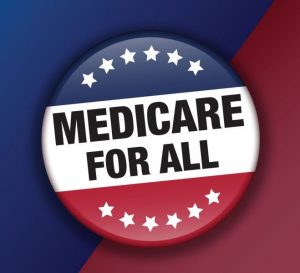
Provided by John Whalley, Principal, Client Executive – Marsh & McLennan Agency
 Whether you follow politics or not, with the 2020 election cycle upon us, there is much debate about how to address health insurance nationally. Generally speaking, the proposals aim to replace most current public and private health insurance with a new federal program that would guarantee coverage for all or nearly all US residents. Coverage may include medical, dental, vision and/or long-term care and may eliminate deductibles, copayments and/or restrictive networks. Proposals are supported by most Democrats and about half of Independents, with most Republicans opposing.
Whether you follow politics or not, with the 2020 election cycle upon us, there is much debate about how to address health insurance nationally. Generally speaking, the proposals aim to replace most current public and private health insurance with a new federal program that would guarantee coverage for all or nearly all US residents. Coverage may include medical, dental, vision and/or long-term care and may eliminate deductibles, copayments and/or restrictive networks. Proposals are supported by most Democrats and about half of Independents, with most Republicans opposing.
How much might it cost and who would pay for it?
In 2018, the US spent roughly $3.65 trillion on healthcare services, approximately 18% of the national GDP. Predictions are that by 2019, healthcare spending will approach $6 trillion and account for 19.4% of GDP. The impact of Medicare for All to these estimates varies widely depending on who is doing the analysis but could increase the national debt by 108% of GDP. There are various ways any increase may be financed, including increased payroll, income or other taxes that may apply to the full population with predictions ranging from 25% to 42% or more, or taxing high earners and corporations. Other options include a mandatory public premium averaging $7,500 per capita, an 80% reduction in non-health federal spending or a combination of options.
Who might be impacted & how?
- 156 million people insured through work would eliminate the premium cost and may see increased wages due to reduced employee benefit costs, but would probably pay higher taxes
- 74 million people with Medicaid would have more choices, but possibly pay higher taxes
- 56 million people currently with Medicare would have more generous coverage
- 28 million uninsureds would get health care insurance coverage
- 22 million people who buy their own insurance would have new taxes, but less out-of-pocket spending
- 9 million Veterans & 2 million Native Americans would keep their existing health care system
How might this impact businesses?
- Drug company profits would likely fall as the government would have more bargaining power to negotiate lower prices
- Health insurance companies would mostly be eliminated, including all the jobs associated with them
- Doctors and hospitals would likely face pay cuts, but would no longer face unpaid bills
- Employers would no longer be responsible for employee benefits, but would pay higher taxes – they would also lose the ability to differentiate themselves by the benefits offered
- Unions would no longer negotiate employee benefits



